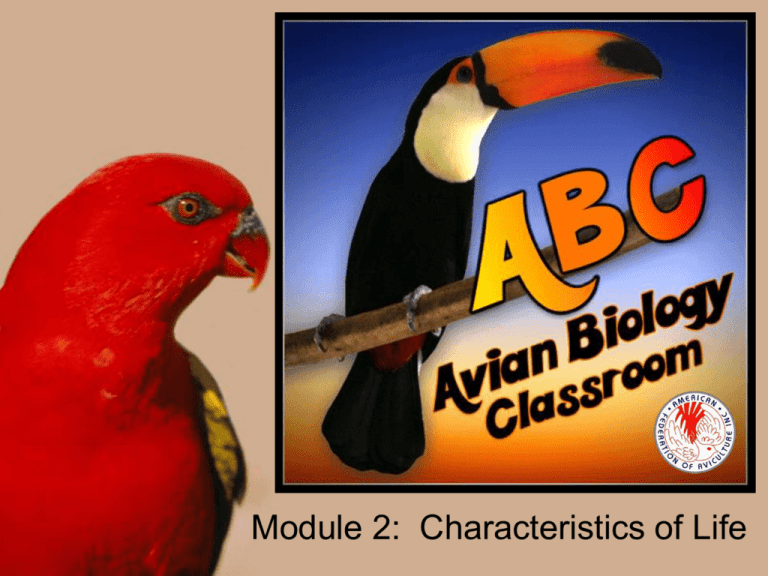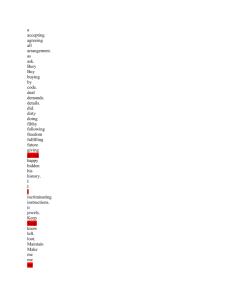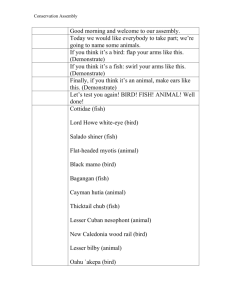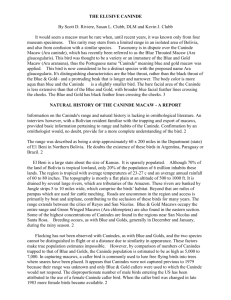
Module 2: Characteristics of Life
To learn even more about birds…
• Take the online
Fundamentals of
Aviculture course I and II!
• A comprehensive course for
all that takes a deeper look
into the lives and science of
birds.
• Visit
www.fundamentalsofaviculture.com
Characteristics of Life
What makes something alive?
Living things are organisms.
• To be considered “living,”
something must possess all
characteristics, not just some.
• If something has all of these
traits, we call it an
“organism.”
• To what other English words
is the word “organism”
related?
Characteristic #1: Made of cells
• All living things are made up
of one or more cells.
• Can you name a species or
group that is unicellular?
• Can you name the major
kingdoms that are all
multicellular?
HUMAN
BIRD
Characteristic #2: Reproduction
• All living things must be able to
reproduce.
• Can you name a species or group
that reproduces asexually?
• Can you name a species or group
that reproduces sexually?
• Why is reproduction a requirement
for life?
Characteristic #3: Genetic code
• All living things must possess a
genetic code to pass down to each
generation.
• Can you name the universal genetic
code?
• Why is it important for DNA to be a
universal language?
Characteristic #4:
Growth & Development
• All living things must grow and
develop over time.
• How do living things grow?
• Give an example of development.
• What specific changes take place
during this development?
Characteristic #5: Metabolism
• All the chemical reactions in an
organism is metabolism.
• What do you think of when you
hear the word metabolism?
• Why is metabolism so important to
us?
Characteristic #6: Response to stimuli
• A stimulus is anything that elicits a
response.
• Why would organisms need to
respond to stimuli?
• Give an example of an organism
responding to stimuli.
Characteristic #7: Homeostasis
• Homeo- (or homo-) means “same”
• Stasis means “to stay,” or “remain.”
• Organisms maintain a stable
internal environment.
• Explain how you maintain
homeostasis.
• Explain how this organism
maintains
homeostasis.
Characteristic #8: Evolution
• Living things must adapt and
change to their changing
environments.
• What evidence has been presented
that illustrates evolution?
• Give an example of an organism’s
adaptations.
Organization of Life
Life is organized into levels of complexity:
• Biosphere: layer around the Earth
that sustains life
• Ecosystem: within the biosphere
are different areas with different
climates
• Community: group of all living
things in an area
• Population: group of a single
species in an area
• Organism: individual living thing
Wow!
That’s really
“organized!”
Avian Science in Action:
Blue-throated macaw
Ara glaucogularis
Special thanks to Laney Rickman for the use of
her photos.
The Blue-throated Macaw
• Ara glaucogularis is critically endangered, with
a small population of approximately 300
individuals in the South American country of
Bolivia.
• This species faces many threats, with a major
current threat being deforestation to make
space for agriculture.
• Private breeding practice has produced a
population of blue-throated macaws to aid in
their survival.
Captive Breeding Helps Conserve
• The Bird Endowment is an organization that works
towards “breaking the extinction vortex into which the
Blue-throated Macaw has been thrust.”
• In the wild, this organization supports
in situ Blue-throated Macaw
conservation projects that are planned
and executed with other organizations.
• In captivity, their breeding facility,
The Blues Conservatory ™ empowers Blue-throated
Macaw parents to fledge and wean their offspring in
the safety of a protected captive environment.
Life is all about survival.
• Chicks have substantial requirements to grow and
develop
• Parents that feed their chicks are
offered a variety of food choices
• Certain food items that are preferred
and selected by parent birds are increased to
ensure their needs are met
• Some chicks have been weighed daily to track their
growth rates
Growth & Development:
It’s part of life
3 weeks
5 weeks
7 weeks
16 weeks
Three generations of breeding success!
Growth & Development
• You will observe growth data on these macaw
chicks and represent them on a graph.
• You will then analyze the data to view the trends in
growth as the chicks progressed.
• You will also compare the data between the sexes.
Weight (grams)
Age (days)
Chick #1
Chick #2
15
290
332
20
396
429
25
525
588
30
640
725
35
690
813
40
723
876
45
760
912
50
772
906
55
799
888
60
770
858
65
764
841
70
730
800
75
704
767
80
668
721
85
623
686
90
642
676
95
638
679
100
638
680
105
640
694
Laney Rickman, Bird Endowment
Laney Rickman is the Executive Director of Bird Endowment Inc. and has
worked as a volunteer keeper in the Bird Department at Houston Zoo from
1991 through 1993. Her first Blue-throated macaws were acquired in 1992
as a wild-caught, bonded pair. They had been together for 10 years but
never attempted to nest at their previous locations in Florida and Texas.
Laney experimented with new techniques and her efforts paid off. The pair
hatched and raised 2 offspring in 1993.
In 1994 she and husband Jack left Houston and moved their Blue-throated
macaw project to a 20-acre farm overlooking the beautiful Guadalupe River
Valley of South Texas. This has evolved into The Blues Conservatory™
which is now Bird Endowment’s domestic breeding facility. The flock is
comprised of founder Blue-throated Macaws, F1, F2 and third generation
parent-reared offspring. Laney is the primary aviculturist at The Blues
Conservatory™.
The Rickmans founded the 501(c)(3) nonprofit Bird Endowment in 1998 to
advance their dedication to breaking the extinction vortex into which the
Bluethroated macaw has been thrust. Their Saving the Blues™ program is
focused on raising public and avicultural awareness of the Blue-throated
Macaw’s plight in captivity and in the wild, where it is critically endangered.
Saving the Blues™ objective in situ is to increase the Blue-throated Macaw
wild population by installing supplemental nests in El Beni. In 2006 Bird
Endowment originated and developed Nido Adoptivo™ or "nest adoption",
an annual funding project in cooperation with the Armonía / Loro Parque
Fundación Blue-throated Macaw Conservation Program in Bolivia.
Rickman with Jason Crean, AFA Regional
Director, and Katy Secor, AFA CFO
About the author…
Jason Crean, MA, MS is a degreed biologist and avid aviculturist,
specializing in the propagation of green aracaris and white-backed
mousebirds, President of The Avicultural Society of Chicagoland, Regional
Director and Education Committee Chair for the American Federation of
Aviculture, and moderates the Holistic Bird Care and Avian Raw, Whole Food
Nutrition groups on Facebook. Crean often speaks to avicultural groups
across the country and acts as consultant to zoos and other institutions,
including the Chicago Nature Museum and Wildlife Genetics lab at Loyola
Medical Center in Chicago, Illinois. He also runs a live animal education
program that does free interactive programs for a host of different audiences
to increase the presence of aviculture.
Crean is also a biology instructor at the high school and university level. He
is also a curriculum designer and instructor in the Education Department at
Chicago Zoological Society. Crean has been awarded the Presidential Award
for Excellence in Science Teaching by President Obama in 2009, the 2010
High School Science Teacher of the Year by the American Association for
the Advancement of Science, as well as awards from the National Science
Teachers Association, the National Association of Biology Teachers, the
Illinois Science Teachers Association, among others. He has authored
several curricula, including the award-winning “Zoo Genetics” curriculum
(www.xy-zoo.com) and “Harry Potter Biology” curriculum
(harrypotterbiology.com). He was also recently awarded the “Teacher of
Distinction” award by the Golden Apple Foundation. He serves as
President-elect for the Illinois Science Teachers Association, Vice-President
for the Illinois Association of Biology Teachers, and sits on the Board for the
Association of Presidential Awardees in Science Teaching and the National
Science Advisory Panel on the national College Board.
For all questions, please contact us at
education@afabirds.org
All rights reserved. No part of this publication may
be reproduced, distributed, altered or transmitted
in any form or by any means, including
photocopying, recording, or other electronic or
mechanical methods, without the prior written
permission of the publisher, except in the case of
copying worksheets for participant use and
certain other noncommercial uses permitted by
copyright law. For permission requests, write to
the publisher, addressed “Attention: Education
Committee Chair,” at the address below.
• American Federation of Aviculture, Inc.
PO Box 91717
Austin TX 78709-1717








